Forget red wine! Whether your heart is broken or bursting with love, Cherokee Grape Dumplings provide the sweetest Valentine’s Day medicine, full of antioxidants known to improve heart health and reduce inflammation (among other cool things).
Oh, and unlike red wine, Grape Dumplings are family-friendly… so go ahead, give your littlest sweethearts a bowl. It’s sure to make their hearts smile.
But – wait! What are Grape Dumplings?
I asked myself this exact question when my friend Deborah handed me a thin cookbook autographed by Cherokee National Treasure, Betty Jo Bean Smith. Constructed with 5 sheets of computer paper and two staples, Traditions in the Kitchen: Favorite Cherokee Meals isn’t available online or in bookstores, but it contains Cherokee treasures such as Poke Eggs and Fried Squirrel. Most of Betty’s recipes use ingredients that locals could easily forage in Oklahoma (as with poke, a leafy plant many might mistake for a weed… and, of course, squirrel, those innocent critters who practically offer themselves up for dinner at Tulsa’s Rose Garden, where I’ve witnessed them climbing people’s legs for peanuts). But it was the grape dumpling recipe that stopped me in my tracks – a concept I’d never heard of before.
Grape dumplings are everything good.
Think soft strips of dough poached in an entire pot of grape juice. Some dumplings are no more than water (or grape juice) and flour, while others are more like a biscuit, leavened with baking powder and butter or shortening. Many roll them out thinly, but I like them a bit on the plumper side.
Here’s the best part… As the dumplings simmer, flour from the dumplings naturally thickens the grape juice into a sweet, dark purple gravy that makes wine seem bitter and hot fudge boring. While some might serve the warm dumplings in a bowl without fuss or ceremony, a little cream or vanilla ice cream on the side is lovely.
What kind of grape juice to use?
Grape Dumplings are a traditional part of Cherokee and Choctaw cooking. You can use a bottle of concord grape juice to keep things simple, but the first Grape Dumplings were simmered in a mash of wild Muscadine grapes (which grow from Oklahoma to Florida and from Texas to Delaware). These deep purple, thick-skinned grapes are also known as Possum Grapes and are rumored to be sour until the first freeze:
These grapes are sour even after they’ve turned a dark purple until a hard freeze came along, then they turn sweet. In other words, they “play possum” until a freeze and that’s how they got their name of “possum grapes.” Though I never tested this personally, my mother and stepfather swore it was true. (Garden Forums)
The dessert’s creation, a result of locals needing to use up a plentiful harvest, reminds me of Canadian Maple Dumplings, which are – get this – soft bits of dough simmered in maple syrup (star, exclamation point, bevel and emboss!!). As you can imagine, Canadians came up with Maple Dumplings thanks to the availability of maple trees and so, so, so much maple syrup. We can thank plentiful harvests and creative local cooks for both of these Oh-my-goodness-that’s-good desserts.
When plants get the feels, medicine is born.
So, you’re on board with Grape Dumplings, but you’re wondering why I’ve dubbed them Medicine for a happy heart. Here’s the skinny: plants have long provided special nutrients and even medicine to humans. Cherokee Indians have a long tradition of acknowledging and even celebrating the contributions of foraged plants to medicine. In fact, there’s an old Cherokee legend that explains why wild plants have been giving humans medicine since waaaaaaay before pharmacies became a street corner standard.
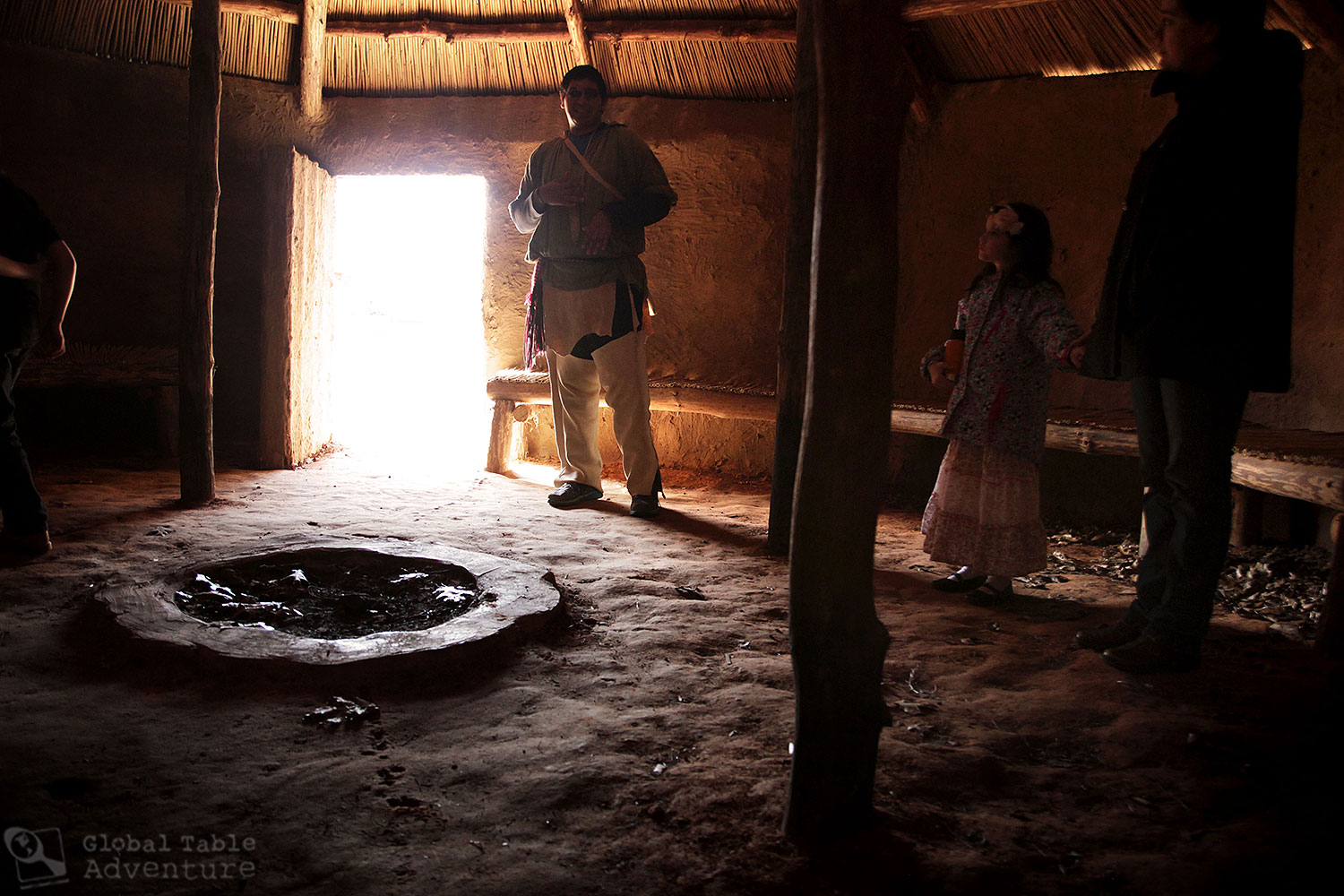
Ava & I inside a winter family house, listening to our guide | Cherokee Village reconstruction (c. 1710)
My husband is part Cherokee on his mother’s side; we recently went to Cherokee Village in Tahlequah, Oklahoma to learn more about this part of his heritage. There isn’t much known except that the Cherokee woman married a white man, moved out of state, and never put her name on the roll. Many Cherokee tried to hide this way so they could avoid discrimination. We felt it was important for Ava to learn more about this part of her lineage. We also want to start telling her Cherokee stories, like the History of Medicine, which I’ve retold in my own words below.
A Cherokee Legend tells the History of Medicine:
But when the two-leggeds grew in numbers they began to think that the Web of Life revolved around them. They soon forgot their promises and began to kill without asking, never gave thanks, and greedily snatched more than what was needed. The Animals, now feeling threatened, banded together and discussed what to do to protect themselves. They decided that, if a two-legged killed an animal and did not give thanks for the sacrifice, the Chief Animal Spirit would afflict them with a terrible disease.
But the plants felt this was too harsh. “If humans don’t find their place in the Web of Life, they will be wiped out by disease. Though the two-leggeds trample, dig, and burn us, we feel compassion for them. If they will listen, we will help them. For every disease the Chief Animal Spirit brings to them, the Plant People will provide a cure. They simply need to pay attention when we speak.”

Tribal council house with logs facing each of the 4 major directions | Cherokee Village reconstruction (c. 1710)
A “Cure” for your Valentine?
After learning Cherokee’s history of medicine, I have a feeling the Plant People spread wild Muscadine grapes around Oklahoma for more than bird food.
My husband, Keith grew up in rural Oklahoma on a meat-and-potatoes diet and has a lot of heart issues (specifically high blood-pressure and atrial fibrillation). I can’t help but wonder if the antioxidants in grapes can help with his troubles. I’ve read that they can help widen blood vessels, which would theoretically help reduce the likelihood of stroke or inflammation. While I don’t see him getting off his medicine after one helping of Grape Dumplings (no, really… don’t go off your medicine after eating these!), the way I look at it, eating a few extra antioxidants can’t hurt… especially in a guy who, when given the chance, will put half a jar of grape jelly on a slice of toast. At the very least, it will connect my husband and daughter a little more to their Cherokee ancestors.
P.S. Three different times while writing this post I accidentally typed the word “Grumplings.” #newfavoriteword
Resources
Traditions in the Kitchen: Favorite Cherokee Meals from Betty Jo Bean Smith, Cherokee National Treasure (sold locally)
Choctaw & Cherokee Recipes (with video)
Cherokee Recipes, Cooking Tips and Lore, by Dean Tackett
Washington Post: Concord Grape Dumplings
Oklahoma Foraging
Cherokee Grape Dumplings just might be the perfect Valentine’s Day dessert. When you share a warm bowl of Grape Dumplings with your lover, you’ll give them a smile and a healthier heart.
| Servings | Prep Time |
| 6 people | 15 minutes |
| Cook Time |
| 10-12 minutes |
|
|
|
This traditional Cherokee Grape Dumpling recipe makes for a fun dessert. Unless birds have scattered possum grape seed in your garden, you'll have to settle for concord grape juice. Ultimately this is quite a bit quicker than mashing your own grapes. Enjoy with vanilla ice cream or a drizzle of cream.
|
- 1 cup all-purpose flour , plus extra for rolling
- 1 tbsp sugar
- 1 1/2 tsp baking powder
- pinch salt
- 2 tbsp unsalted butter
- 1/2 cup concord grape juice
- 3 1/2 cups concord grape juice
- 1/2 cup sugar
- heavy cream
- vanilla ice cream
- Whisk together the flour, sugar, baking powder, and salt. Cut in the butter with a pastry blender or 2 knives until the butter is pea-sized or smaller. Add in the 1/2 cup grape juice and mix until just combined. (If you overmix it, it'll be tough)
- On a heavily floured board, press the dough into a flat disc. You can roll it thinly, but I like them a little on the thick side. Cut into bite-sized bits with a pastry cutter or ravioli wheel.
- Heat up the remaining grape juice and sugar in a large skillet with high sides until simmering. Drop in the dumplings and simmer for 10-12 minutes, stirring once or twice to make sure they don't stick together. The grape juice should thicken into a sweet gravy. Serve immediately in bowls either plain, with heavy cream drizzled on top, or a big scoop of vanilla ice cream.




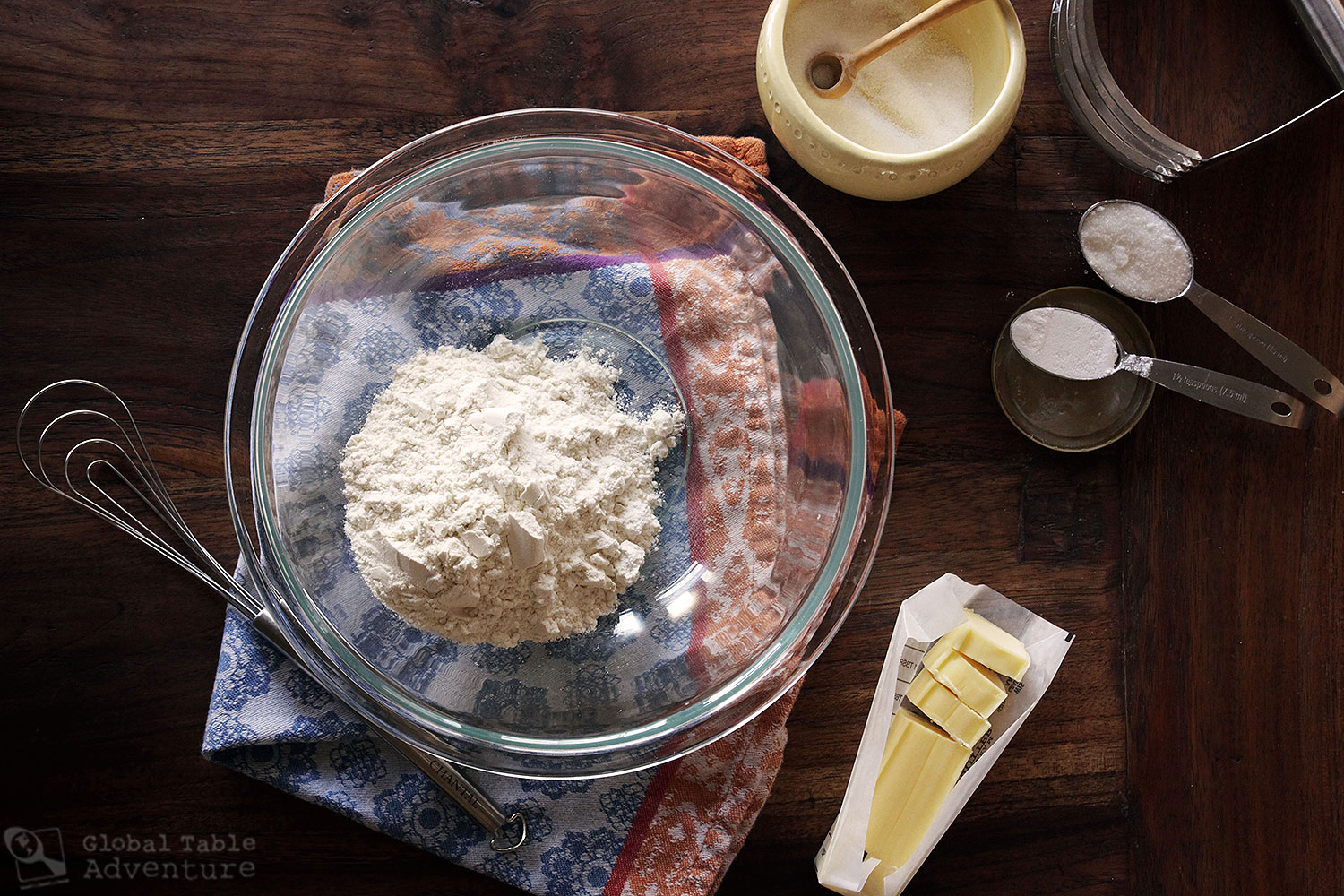
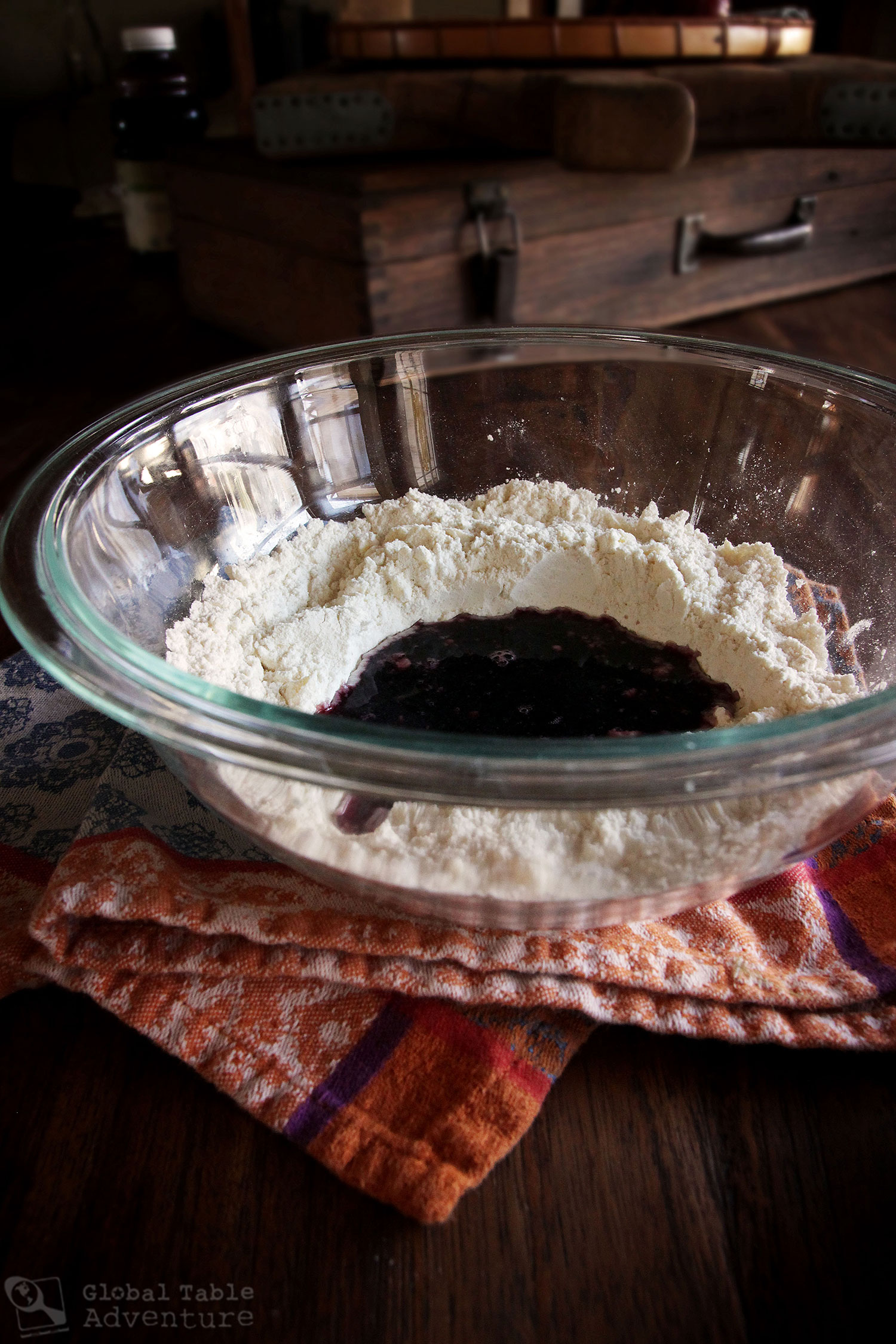

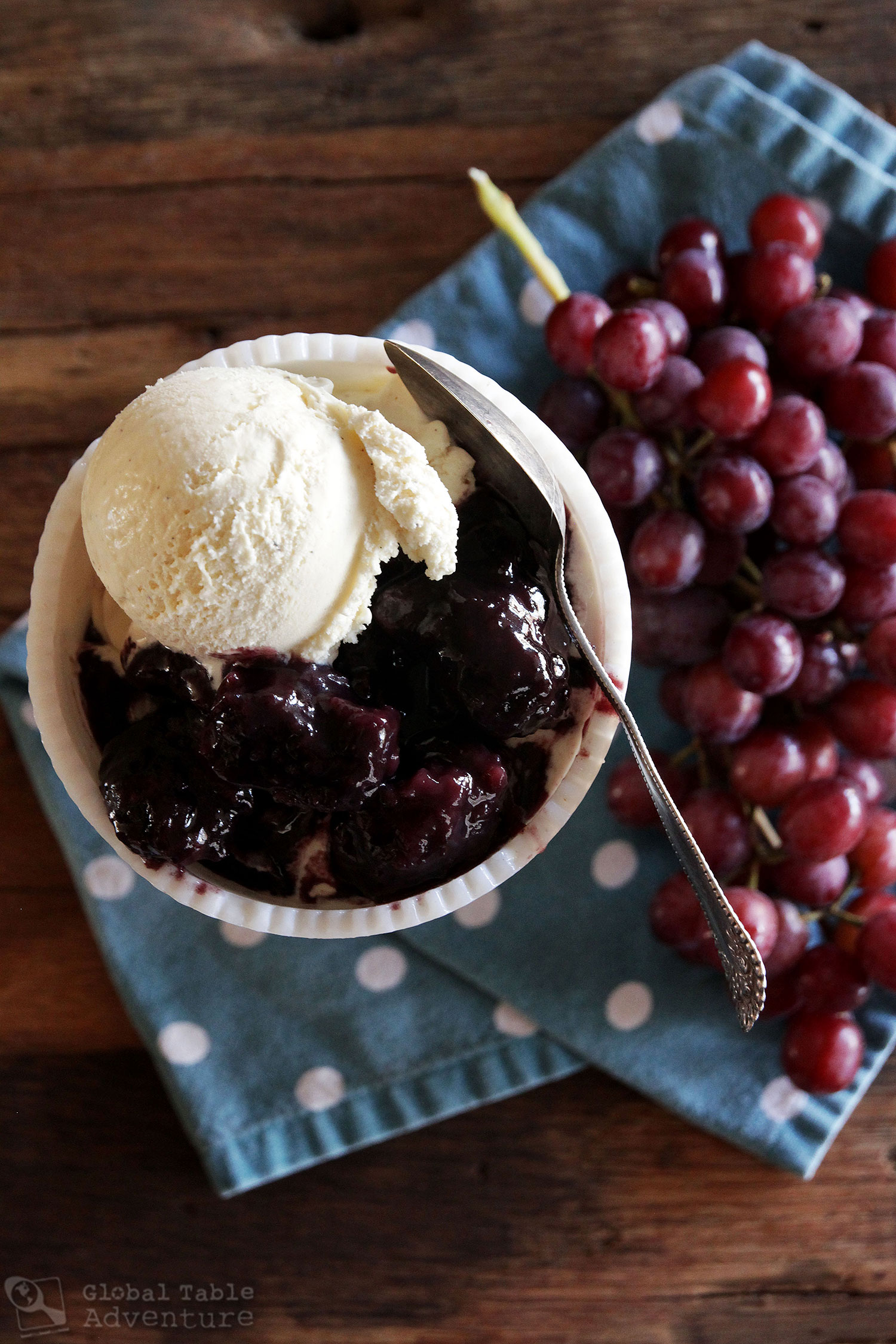
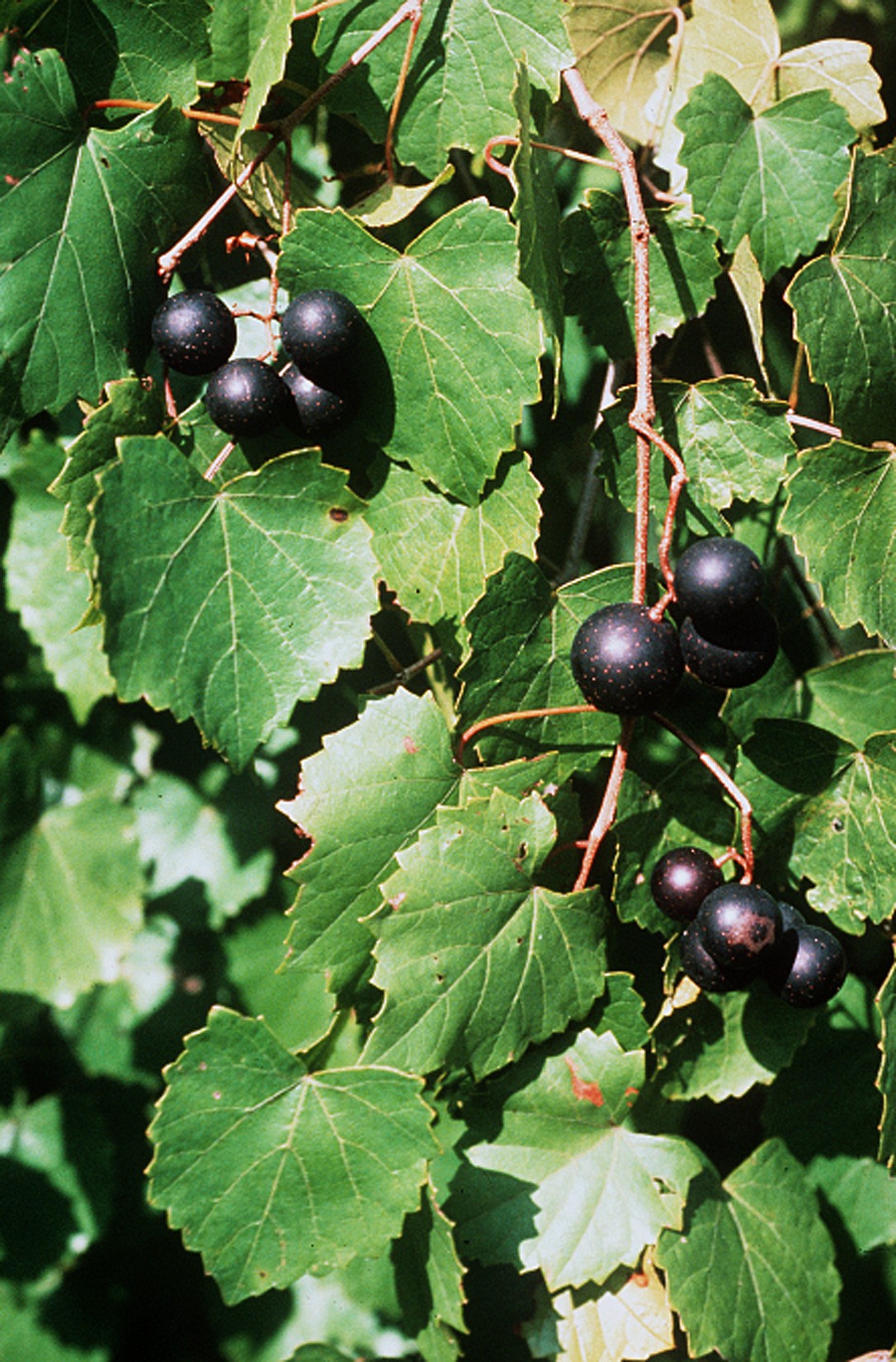

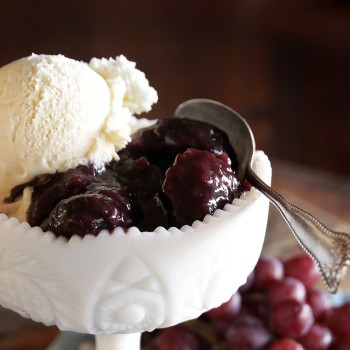

29 Comments